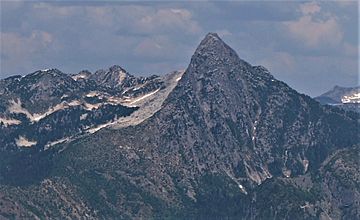Pocket Peak facts for kids
Quick facts for kids Pocket Peak |
|
|---|---|

Pocket Peak, west aspect
|
|
| Highest point | |
| Elevation | 7,056 ft (2,151 m) |
| Prominence | 1,136 ft (346 m) |
| Isolation | 2.25 mi (3.62 km) |
| Parent peak | Rapid Peak (7,259 ft) |
| Geography | |
| Location |
|
| Parent range | Cascade Range North Cascades Skagit Range |
| Topo map | USGS Mount Sefrit |
| Climbing | |
| First ascent | 1967 D. McKeever, R. Tabor |
| Easiest route | class 4 scrambling |
Pocket Peak is a mountain in Washington state, standing tall at about 7,056-foot (2,151-metre) (2,151 meters). It's part of the Skagit Range, which is a smaller section of the larger North Cascades mountain range. You can find it in Whatcom County.
This peak is located right next to Pocket Lake. It's also about 4 mi (6.4 km) (6.4 km) east of Mount Larrabee. Pocket Peak is inside the Mount Baker Wilderness, an area managed by the Mount Baker-Snoqualmie National Forest.
Pocket Peak sits very close to the Canada–United States border, only about 0.7 miles (1.1 km) south of it. Its closest taller neighbor is Rapid Peak, which is about 2.24 mi (3.60 km) (3.6 km) to the southeast. From the top of Pocket Peak, you can see many other famous mountains like Mount Baker and Mount Shuksan. This mountain doesn't have an official name, but it's called Pocket Peak because of its closeness to Pocket Lake. Water from the mountain flows into Silesia and Ensawkwatch Creeks, which then join the Chilliwack River.
Contents
What's the Weather Like at Pocket Peak?
Pocket Peak is in a "marine west coast" climate zone. This means it gets a lot of moisture from the Pacific Ocean. This type of climate even helps a small glacier form on the mountain's north side!
How Weather Forms in the Cascades
Most weather systems start over the Pacific Ocean and move towards the Cascade Range. When these systems hit the tall mountains, they are forced to rise. As the air rises, it cools down and drops its moisture as rain or snow. This is why the western side of the North Cascades gets a lot of precipitation, especially in winter.
Temperatures and Snowfall
Because it's close to the ocean, the area around Pocket Peak rarely gets extremely cold (below 0 °F (−18 °C)) or very hot (above 80 °F (27 °C)). In winter, it's often cloudy, but summer usually brings clear skies. The snow here tends to be wet and heavy, which can increase the risk of avalanches. The best time to visit or climb Pocket Peak is from July to September, when the weather is usually clear and mild.
How Was Pocket Peak Formed?
The North Cascades mountains, including Pocket Peak, have very rugged and dramatic landscapes. You'll see sharp peaks, long ridges, and deep valleys carved by glaciers. These amazing features were created by geological events that happened millions of years ago.
Ancient Earth Movements
The Cascade Range began forming millions of years ago, during a time called the late Eocene Epoch. This happened because the North American Plate (a huge piece of Earth's crust) was slowly moving over the Pacific Plate. This movement caused a lot of volcanic activity.
For example, the Hannegan Caldera, a large volcanic crater, erupted four million years ago. This eruption was a sign of the volcanic activity that would later form Mount Baker. Also, small pieces of Earth's crust, called terranes, came together to create the North Cascades about 50 million years ago.
The Power of Glaciers
During the Pleistocene period, which started over two million years ago, huge sheets of ice called glaciers repeatedly moved across the land. As they moved, they scraped and shaped the landscape, leaving behind rock and debris. The U-shaped valleys you see in the mountains today were carved out by these ancient glaciers.
The combination of the land pushing upwards (called uplift) and cracks in the Earth's crust (called faulting), along with the powerful action of glaciers, created the tall peaks and deep valleys of the North Cascades area.



